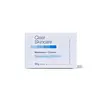What's inside
What's inside
 Key Ingredients
Key Ingredients

 Benefits
Benefits

 Concerns
Concerns

 Ingredients Side-by-side
Ingredients Side-by-side

Water
Skin ConditioningGlycerin
HumectantIsopropyl Palmitate
EmollientCetyl Alcohol
EmollientCetearyl Olivate
Sorbitan Olivate
EmulsifyingC10-30 Cholesterol/Lanosterol Esters
EmulsifyingCaprylyl Glycol
EmollientEthylhexylglycerin
Skin ConditioningBetaine
HumectantDimethicone
EmollientPalmitic Acid
EmollientStearic Acid
CleansingPolyacrylate Crosspolymer-6
Emulsion StabilisingPentylene Glycol
Skin ConditioningSodium PCA
HumectantFructose
HumectantSodium Hyaluronate
HumectantSodium Lactate
BufferingUrea
BufferingSodium Hydroxide
BufferingCitric Acid
BufferingPCA
Humectant1,2-Hexanediol
Skin ConditioningMaltose
MaskingCeramide NP
Skin ConditioningSerine
MaskingAlanine
MaskingSodium Chloride
MaskingTrehalose
HumectantGlycine
BufferingAllantoin
Skin ConditioningGlutamic Acid
HumectantLysine Hcl
Skin ConditioningArginine
MaskingThreonine
Tropolone
Skin ConditioningGlucose
HumectantProline
Skin ConditioningWater, Glycerin, Isopropyl Palmitate, Cetyl Alcohol, Cetearyl Olivate, Sorbitan Olivate, C10-30 Cholesterol/Lanosterol Esters, Caprylyl Glycol, Ethylhexylglycerin, Betaine, Dimethicone, Palmitic Acid, Stearic Acid, Polyacrylate Crosspolymer-6, Pentylene Glycol, Sodium PCA, Fructose, Sodium Hyaluronate, Sodium Lactate, Urea, Sodium Hydroxide, Citric Acid, PCA, 1,2-Hexanediol, Maltose, Ceramide NP, Serine, Alanine, Sodium Chloride, Trehalose, Glycine, Allantoin, Glutamic Acid, Lysine Hcl, Arginine, Threonine, Tropolone, Glucose, Proline
Water
Skin ConditioningGlycerin
HumectantIsopropyl Myristate
EmollientDicaprylyl Carbonate
EmollientPolyglyceryl-3 Methylglucose Distearate
EmulsifyingCetearyl Alcohol
EmollientCetyl Ethylhexanoate
EmollientButyrospermum Parkii Butter
Skin Conditioning1,2-Hexanediol
Skin ConditioningCyclopentasiloxane
EmollientSaccharide Isomerate
HumectantHydroxyethyl Acrylate/Sodium Acryloyldimethyl Taurate Copolymer
Emulsion StabilisingGlyceryl Stearate
EmollientHydroxyacetophenone
AntioxidantPEG-100 Stearate
Xanthan Gum
EmulsifyingPolysorbate 60
EmulsifyingSorbitan Isostearate
EmulsifyingDisodium EDTA
Callitris Glaucophylla Leaf Extract
Skin ConditioningBeta-Glucan
Skin ConditioningCitric Acid
BufferingPropanediol
SolventSodium Citrate
BufferingHyaluronic Acid
HumectantTocopherol
AntioxidantCaprylhydroxamic Acid
Sodium Benzoate
MaskingEthylhexylglycerin
Skin ConditioningPhenoxyethanol
PreservativeWater, Glycerin, Isopropyl Myristate, Dicaprylyl Carbonate, Polyglyceryl-3 Methylglucose Distearate, Cetearyl Alcohol, Cetyl Ethylhexanoate, Butyrospermum Parkii Butter, 1,2-Hexanediol, Cyclopentasiloxane, Saccharide Isomerate, Hydroxyethyl Acrylate/Sodium Acryloyldimethyl Taurate Copolymer, Glyceryl Stearate, Hydroxyacetophenone, PEG-100 Stearate, Xanthan Gum, Polysorbate 60, Sorbitan Isostearate, Disodium EDTA, Callitris Glaucophylla Leaf Extract, Beta-Glucan, Citric Acid, Propanediol, Sodium Citrate, Hyaluronic Acid, Tocopherol, Caprylhydroxamic Acid, Sodium Benzoate, Ethylhexylglycerin, Phenoxyethanol
 Reviews
Reviews

Ingredients Explained
These ingredients are found in both products.
Ingredients higher up in an ingredient list are typically present in a larger amount.
1,2-Hexanediol is a synthetic liquid and another multi-functional powerhouse.
It is a:
- Humectant, drawing moisture into the skin
- Emollient, helping to soften skin
- Solvent, dispersing and stabilizing formulas
- Preservative booster, enhancing the antimicrobial activity of other preservatives
Citric Acid is an alpha hydroxy acid (AHA) naturally found in citrus fruits like oranges, lemons, and limes.
Like other AHAs, citric acid can exfoliate skin by breaking down the bonds that hold dead skin cells together. This helps reveal smoother and brighter skin underneath.
However, this exfoliating effect only happens at high concentrations (20%) which can be hard to find in cosmetic products.
Due to this, citric acid is usually included in small amounts as a pH adjuster. This helps keep products slightly more acidic and compatible with skin's natural pH.
In skincare formulas, citric acid can:
While it can provide some skin benefits, research shows lactic acid and glycolic acid are generally more effective and less irritating exfoliants.
Most citric acid used in skincare today is made by fermenting sugars (usually from molasses). This synthetic version is identical to the natural citrus form but easier to stabilize and use in formulations.
Read more about some other popular AHA's here:
Learn more about Citric AcidEthylhexylglycerin (we can't pronounce this either) is commonly used as a preservative and skin softener. It is derived from glyceryl.
You might see Ethylhexylglycerin often paired with other preservatives such as phenoxyethanol. Ethylhexylglycerin has been found to increase the effectiveness of these other preservatives.
Glycerin is already naturally found in your skin. It helps moisturize and protect your skin.
A study from 2016 found glycerin to be more effective as a humectant than AHAs and hyaluronic acid.
As a humectant, it helps the skin stay hydrated by pulling moisture to your skin. The low molecular weight of glycerin allows it to pull moisture into the deeper layers of your skin.
Hydrated skin improves your skin barrier; Your skin barrier helps protect against irritants and bacteria.
Glycerin has also been found to have antimicrobial and antiviral properties. Due to these properties, glycerin is often used in wound and burn treatments.
In cosmetics, glycerin is usually derived from plants such as soybean or palm. However, it can also be sourced from animals, such as tallow or animal fat.
This ingredient is organic, colorless, odorless, and non-toxic.
Glycerin is the name for this ingredient in American English. British English uses Glycerol/Glycerine.
Learn more about GlycerinWater. It's the most common cosmetic ingredient of all. You'll usually see it at the top of ingredient lists, meaning that it makes up the largest part of the product.
So why is it so popular? Water most often acts as a solvent - this means that it helps dissolve other ingredients into the formulation.
You'll also recognize water as that liquid we all need to stay alive. If you see this, drink a glass of water. Stay hydrated!
Learn more about Water